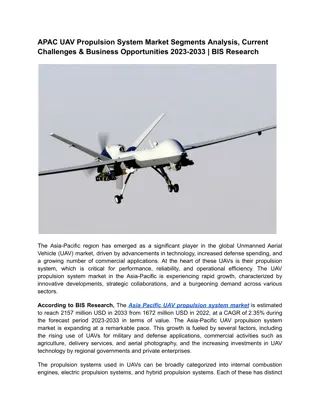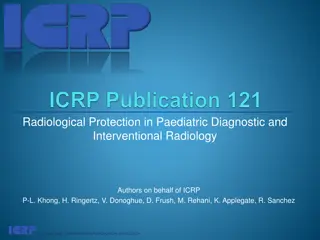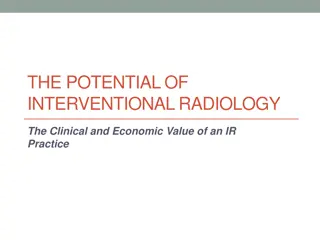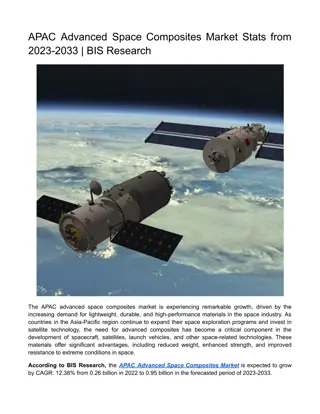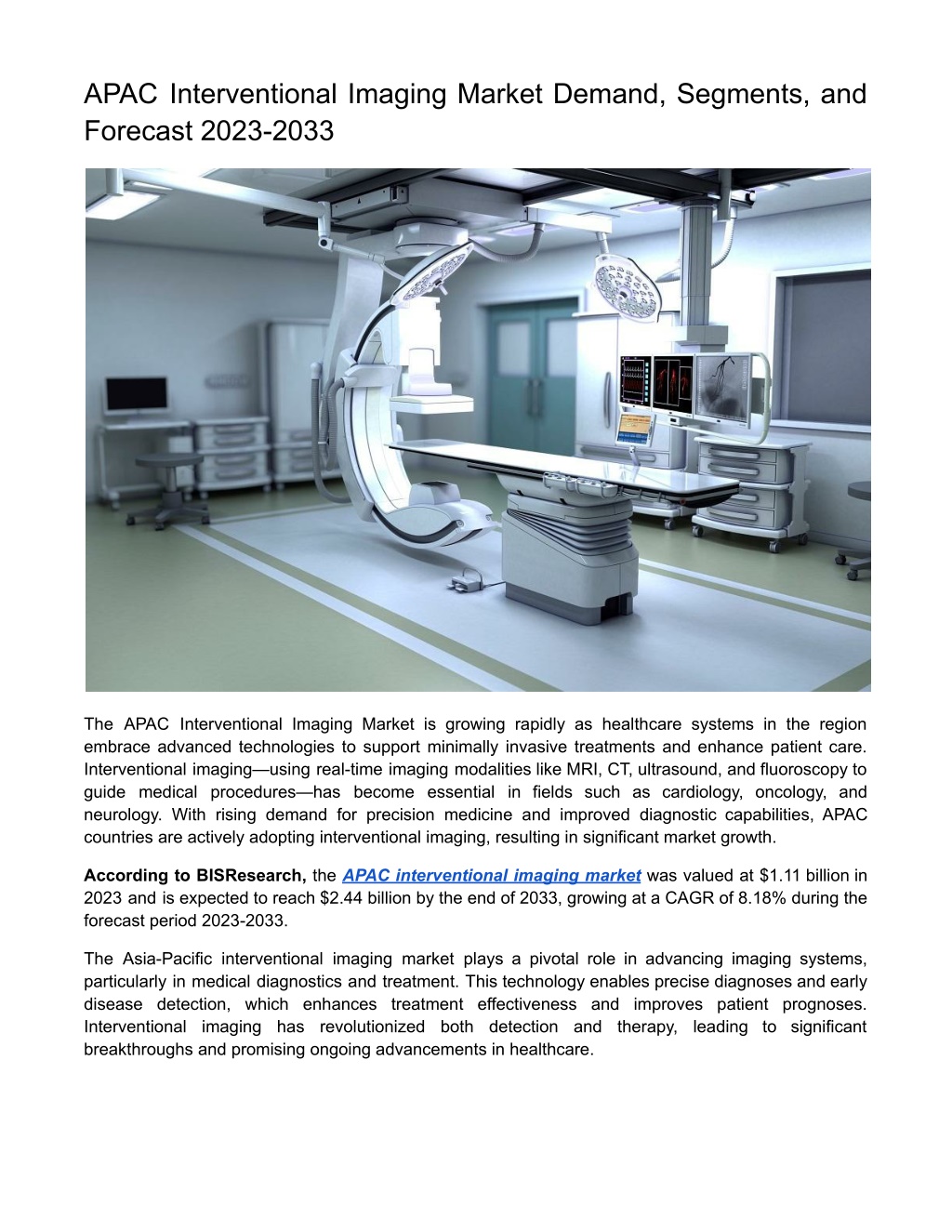
APAC Interventional Imaging Market Demand, Segments, and Forecast
The APAC interventional imaging market was valued at $1.11 billion in 2023 and is expected to reach $2.44 billion by the end of 2033, growing at a CAGR of 8.18% during the forecast period 2023-2033.nnRead Report Overview: //bisresearch.com/indus
Download Presentation

Please find below an Image/Link to download the presentation.
The content on the website is provided AS IS for your information and personal use only. It may not be sold, licensed, or shared on other websites without obtaining consent from the author. Download presentation by click this link. If you encounter any issues during the download, it is possible that the publisher has removed the file from their server.
E N D
Presentation Transcript
APAC Interventional Imaging Market Demand, Segments, and Forecast 2023-2033 The APAC Interventional Imaging Market is growing rapidly as healthcare systems in the region embrace advanced technologies to support minimally invasive treatments and enhance patient care. Interventional imaging using real-time imaging modalities like MRI, CT, ultrasound, and fluoroscopy to guide medical procedures has become essential in fields such as cardiology, oncology, and neurology. With rising demand for precision medicine and improved diagnostic capabilities, APAC countries are actively adopting interventional imaging, resulting in significant market growth. According to BISResearch, the APAC interventional imaging market was valued at $1.11 billion in 2023 and is expected to reach $2.44 billion by the end of 2033, growing at a CAGR of 8.18% during the forecast period 2023-2033. The Asia-Pacific interventional imaging market plays a pivotal role in advancing imaging systems, particularly in medical diagnostics and treatment. This technology enables precise diagnoses and early disease detection, which enhances treatment effectiveness and improves patient prognoses. Interventional imaging has revolutionized both detection and therapy, leading to significant breakthroughs and promising ongoing advancements in healthcare.
Key Drivers in the APAC Interventional Imaging Market Increasing Prevalence of Chronic Diseases: Chronic conditions, such as cardiovascular diseases, cancer, and neurological disorders, are on the rise in APAC due to aging populations, urbanization, and lifestyle changes. Interventional imaging plays a crucial role in diagnosing and treating these conditions, driving demand for high-quality imaging solutions. Growing Demand for Minimally Invasive Procedures: Patients and healthcare providers increasingly prefer minimally invasive options due to their benefits, including shorter hospital stays, lower risks of complications, and faster recovery times. Interventional imaging facilitates these procedures by providing accurate, real-time guidance that enhances surgical precision. Technological Advancements: Innovations in imaging technologies, such as 3D imaging, artificial intelligence (AI), and hybrid imaging systems, are transforming interventional procedures. These advancements enable healthcare professionals to make faster, more accurate decisions, thereby improving outcomes and fostering growth in the interventional imaging market. Government Investments and Initiatives: APAC governments are investing in healthcare infrastructure to expand access to advanced medical technologies. For instance, countries like China, Japan, and India have implemented healthcare modernization initiatives that include funding for imaging technology and support for minimally invasive solutions. Increasing Access in Rural Areas: Although advanced healthcare services are more common in urban areas, rural regions across APAC are also experiencing a rising demand for interventional imaging. Portable and mobile imaging devices, such as handheld ultrasound and compact CT systems, are helping bridge the gap, improving healthcare access in underserved regions. Request A Detailed Sample on APAC Interventional Imaging Market! APAC Interventional Imaging Market by Application Cardiology Neurology Musculoskeletal Oncology Urology Gastroenterology Obstetrics Gynaecology Challenges in the APAC Interventional Imaging Market Despite rapid growth, the APAC interventional imaging market faces a few challenges: High Equipment Costs: The cost of advanced imaging equipment can be prohibitive for smaller clinics and healthcare providers, especially in emerging economies. Addressing this issue will likely require government subsidies, financial support, and low-cost imaging solutions tailored to APAC markets.
Shortage of Trained Professionals: Operating interventional imaging equipment requires specialized training. Many regions in APAC lack a sufficient number of trained radiologists and technicians, which can limit the adoption of these technologies. Regulatory Variability: Differing regulatory standards across APAC countries can slow the approval and distribution of new imaging technologies. Harmonizing these standards would simplify market entry for companies and improve patient access to innovative solutions. Future Outlook The APAC Interventional Imaging Market is bright, driven by innovations in AI and machine learning, increasing access to rural healthcare, and collaborative public-private partnerships. Portable and cost-effective imaging solutions are expected to widen adoption, especially in underserved areas. With rising healthcare investment and demand for minimally invasive procedures, the market is poised for strong growth. These advancements will enhance diagnostic accuracy and efficiency, improving patient outcomes and making interventional imaging more accessible across the APAC region. Download Our ToC: Click Here! Conclusion The APAC Interventional Imaging Market is on a path of strong growth, driven by an increasing demand for minimally invasive procedures, technological infrastructure. While challenges around cost, access, and skilled personnel remain, innovations in AI and hybrid ORs, along with government support, are set to shape the future of this market. As interventional imaging becomes more widely accessible across the APAC region, it will play a pivotal role in improving patient care and outcomes, particularly in fields like cardiology, oncology, and neurology. advancements, and expanding healthcare




